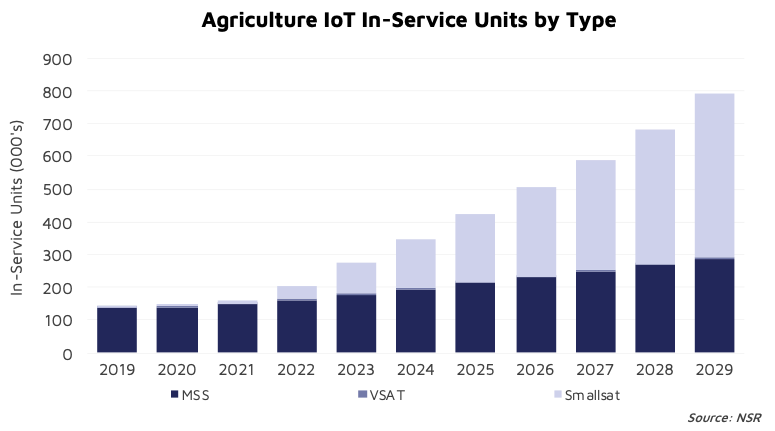Fertile Ground in Agriculture IoT
M2M and IoT over satellite have mainly been implemented in cargo and transport applications, as well as in energy markets. However, one application (agriculture) is expected to buck the existing trend and achieve outsized returns…how can operators capture this growth, and excel in this increasingly competitive market?

In NSR’s recently released M2M and IoT via Satellite 11th Edition report, it was found that agriculture use cases will have one of the highest growth prospects over the next decade, especially as smallsat IoT constellations enter the market over the coming years. The number of in-service units for agricultural applications will rise from 130,000 in 2019 to over 790,000 in 2029, with the lion’s share (63%) of growth via smallsats, and animal tracking, heavy equipment and meter reading are the main drivers.
The rise of smallsat demand for this market is driven by the fact that hardware cost remains a restraint for farmers, especially owner-operator farms, particularly those outside North America. The low-price points of smallsat terminals are expected to be able to enter this more price sensitive market segment. This is especially important when hundreds of thousands of terminals are required as is the case here. Small satellite operators are already targeting selling terminals to heavy equipment manufacturers, and trials are underway in Australia in this segment, which is a key market given three quarters of the country has no terrestrial network coverage.
Consequently, the equipment play will be strong as equipment sales to heavy equipment manufacturers will bulk up revenues. However not all of these will eventually become activated, and there may be a long period between when a unit is sold to an OEM and the service eventually activated by the end user.
On the other end of the spectrum, Iridium and Inmarsat will be capable of supporting precision agriculture type applications. Iridium Certus (22 kbps service and higher speeds) and BGAN M2M can backhaul usage through LoRaWAN terrestrial technologies, and for large animal populations within a ~15km radius, which represents a better value proposition to end users.
Both offerings are complementary but given the competition of smallsats in the coming years, greater bandwidth solutions combined with backhaul are a stronger bet longer term for MSS operators. This is as bandwidth requirements will increase as more sensor data will be collected, from collecting rainfall data, moisture content, fertilization, plant growth and many others on a ‘grid’ to determine the variation of parameters within a single property, or between properties nearby and afar. With precision GPS, as well as more data required to be downloaded, these will significantly increase ARPUs within the application. This might also slightly tilt the market towards upcoming VSAT solutions such as HiSky’s Ka-band, and eventually higher bandwidth Ku-band terminals. However, smallsats can still play a significant role in this with backhauled solutions.
For all types of M2M architectures, the key strategy to target this application is both long battery life and small size and is something that small satellite constellations are planning to target with their terminal designs and architectures. Globalstar also has a very successful product with its simplex chip sold through FindMy (formally FindMySheep) and Lotek, which are two major providers of agricultural use cases for animal tracking. While Globalstar is a leader in this segment, if smallsat operators are able to leverage even lower costs for both service and equipment, this will leave Globalstar in a tough spot, as competitive pricing is paramount for animal tracking, and latency generally not an issue.
Bottom Line
Despite increased penetration of terrestrial technologies, including LPWA networks, there is the lack of a mobile operator-led push for agriculture M2M, which leaves an opening for satellite to play a larger role. Developing terminals with low cost and low power drain are paramount to excelling in the soon to be fast growing market. However, application specific expertise is required to lay the technical groundwork to operate in such a market, so developing relationships with service providers is key. Further, partnerships with OEMs such as John Deere, Claas, and CNH Industrial are also key to growth, and will increase distribution channels and thus subscribers, especially for line-fit products. Ultimately, persuading and educating end-users on the benefits of IoT will be needed; however, once achieved, there will certainly be fertile markets for all.
